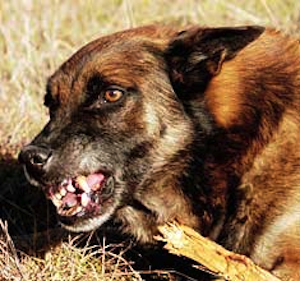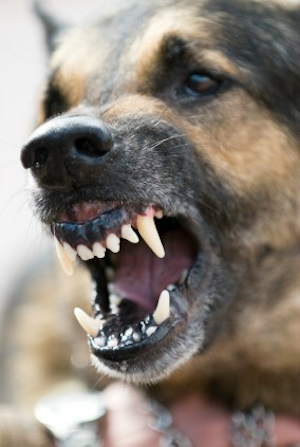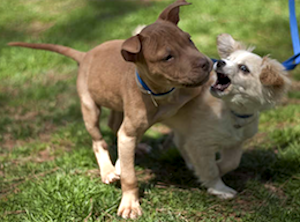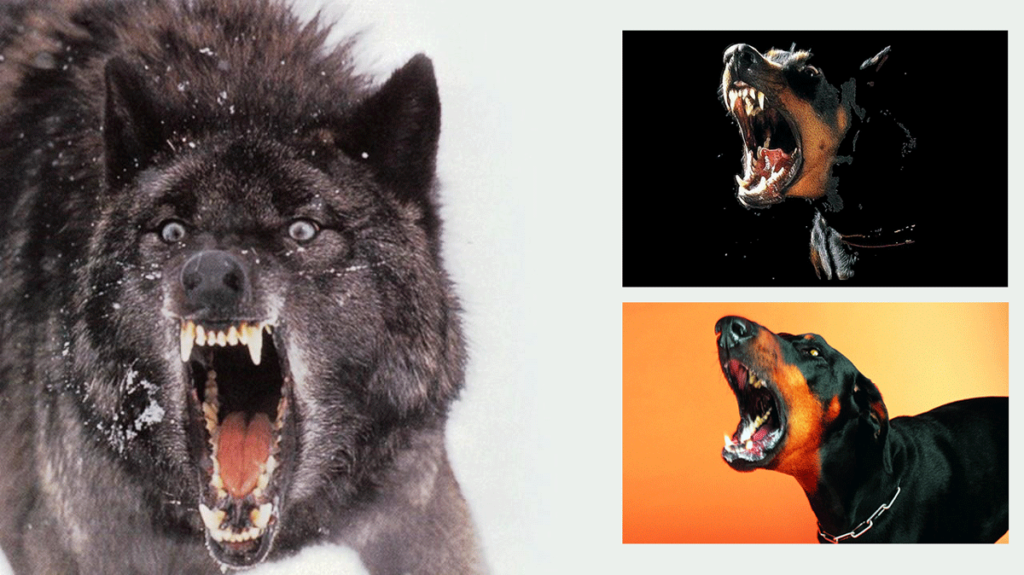
Aggressive and dominant (self-confident) behavior (picture from Dogsquad).

Aggressive and submissive behavior (not fearful). That is the behavior a cornered dog shows when pacifying, submission and flight don’t work (picture from Doggies).

Aggressive and submissive behavior (ears down, long mouth, smaller eyes) (picture from Cesar’sWay).

Growling and snarling are also aggressive behaviors (picture from Askmen).

This dog shows self-confident (dominant) aggressive behavior. This is instrumental aggressive behavior (photo from dog-adoption-and-training-guide).

This dog shows insecurity and aggressive behavior. This may be reactive-impulsive aggressive behavior, but may also be learned behavior (photo by petexpertise.com).

This dog (to the right) shows learned aggressive behavior. It may be impulsive-reactive, but it does not need to be (photo by onegreenplanet.org).

Aggressive behavior? Not so far, but it can quickly become depending on how strong-minded the dogs are, how much self-control they possess, and the value of what is at stake. So far, both dogs show strong dominant behavior, which is distinguishable from aggressive behavior (picture from dogtime.com).
Contrary to what you might suppose, aggressive behavior is difficult to define. “Lack of agreement regarding definitions of aggressive behavior has been a significant impediment to the progress of research in this area,” writes Nelson in 2005 in his big book “Biology of Aggression.”
The Making of a Definition
Why is a good definition necessary? Because only then do we know what we are discussing.
I have never been quite satisfied with my own definition, and it nags me when I can’t come up with a good definition. I have often returned to it, changing a comma or two to see if it improved. Alas, to no avail, updated versions were marginally better, but not resoundingly so.
My original definition, let me remind you, was: “Aggressiveness (or aggressive behavior) is behavior directed toward the elimination of competition. It can range from displays of intent, like growling, roaring and stamping to injuring behavior like biting, staging, kicking.”
It’s not bad, but it could be better. I checked many other definitions to analyze their strengths and shortcomings, hoping to get the necessary inspiration to come up with a near-perfect definition.
A— “Aggressive behavior is behavior that causes physical or emotional harm to others, or threatens to. It can range from verbal abuse to the destruction of a victim’s personal property” (www.healthline.com/health/).
It’s not bad, but not precise enough to use in the biological sciences.
B— “Aggression is a forceful behavior, action, or attitude that is expressed physically, verbally, or symbolically. It may arise from innate drives or occur as a defense mechanism, often resulting from a threatened ego. It is manifested by either constructive or destructive acts directed toward oneself or against others (Mosby’s Medical Dictionary, 8th edition).”
Not bad either, though weakened by the passive voice. It recurs to terms also needing strong definitions, i.e., drive, defense mechanism. Finally, it is a bit too psychological for the evolutionary biologist—what is a threatened ego?
C— “Aggression is behavior that is angry and destructive and intended to be injurious, physically or emotionally, and aimed at domination of one animal by another. It may be manifested by overt attacking and destructive behavior or by covert attitudes of hostility and obstructionism. The most common behavioral problem seen in dogs.” (http://medical-dictionary.thefreedictionary.com/Aggressive+Behaviour).
This one is not good. It is more a list of synonyms (angry, destructive, hostility, obstructionism) than a definition. It mixes concepts too easily (aggression and domination?). Finally, the most common problem in dogs in our files (over 10,000) is home-alone problems, not aggressive (whatever that is) behavior.
D— “Aggressive people often uses anger, aggressive body language […] “(http://changingminds.org/techniques/assertiveness/aggressive_behavior.htm).
We won’t waste any more time with this one. A definition that uses the definiendum is not a definition.
E— “Aggression is a response to something/someone the animal perceives as a threat. Aggression is used to protect the animal through the use of aggressive displays (growling, barking, tooth displays, etc.) or protect the animal through aggressive acts (biting). Aggressive behavior is most frequently caused by fear.” (somewhere on the Internet).
This one is not good either. Again, it uses the definiendum in the definition. We miss the definition of threat to be able to analyze the sentence conclusively. More seriously, it states that aggression is caused by fear, which from an evolutionary point of view doesn’t make sense. Fear does not elicit aggressive behavior. It would have been a lethal strategy that natural selection would have eradicated swiftly and once and for all. A cornered animal does not show aggressive behavior because it is fearful. It does so because its natural responses to a fear-eliciting stimulus (pacifying, submission, flight) don’t work.
F— “Aggression is defined as behavior which produced or was intended to produce physical injury or pain in another person.” (Nelson, R. .J. 2005. Biology of Aggression. Oxford Univ. Press).
That is a much better definition, although it could be more explanatory.
So, after yet another round of deliberation, here follows my suggestion.
“Aggressive behavior is directed toward eliminating competition from an opponent, injuring it, inflicting it pain, or giving it a reliable warning of such impending consequences if it takes no evasive action. It is distinguishable from dominant behavior in as much as the latter does not include harmful behaviors though it may require some degree of forceful measures. Aggressive behavior ranges from reliable warnings of impending damaging behavior, such as growling, roaring, and stamping, to harmful behaviors, such as biting, staging, and kicking. Predatory behavior is not aggressive behavior.”
That is much better than earlier versions and complies with all the requirements for a good definition. Thus:
- It defines something concrete and observable.
- It states a necessary condition to distinguish it from a related technical term, dominant behavior, even explaining a characteristic of the latter.
- It does not include other terms needing a definition.
- It includes enough conditions to justify the use of the term, not too few to risk being synonymous with another term, and not too many to risk losing its explanatory value by being too encompassing.
- It gives examples of what is and is not aggressive behavior.
- It does not presuppose any special knowledge of the reader to understand it.
That is a good definition because it defines the term, including and excluding the necessary conditions. Whether it will be the last word on the matter is another story. I’m sure it won’t. There is always room for improvement. A good definition must also be able to accept reviews imposed by newer discoveries. Until then, I’m happier with this one than with any earlier versions.
Aggression Types
Having dealt with the definition of aggressive behavior, we will now analyze the various types of aggressive behavior and their correlation to genetics. Although a strong definition of aggressive behavior is a promising step to understanding it, we have not resolved all matters and still need to clarify a few other terms. Note that in the following, to make it shorter, we will use aggression and aggressive behavior interchangeably.
When studying human aggression, it is common to subdivide it into two types: (1) instrumental aggression, which is purposeful or goal-oriented; and (2) reactive-impulsive aggression, which is elicited by loss of emotional control and often manifests itself as uncontrollable or inadequate actions.
Let us also note that “Aggression differs from what is commonly called assertiveness, although the terms are often used interchangeably among lay people (as in phrases such as ‘an aggressive salesperson'” in Quadri and Vidhate’s words. They also state, “Predatory or defensive behavior between members of different species may not be considered aggression in the same sense.” I would go a step further and insist we do not consider these behaviors as aggressive behavior in any sense. The functions of predatory or defensive behavior among members of different species are quite distinct from the antagonistic (aggressive) behavior among conspecifics due to competition over resources.
A distinction in types of aggressive behaviors is between (1) pro-active (also controlled and instrumental) and (2) reactive-impulsive. The former is not an end per se, only the means to achieve a goal. There are no strong emotions involved. On the contrary, its effects depend on deliberate and well-timed action. The latter has no goal in itself and is marked by intense emotions. In short, researchers of aggressive behavior in children have found it helpful to distinguish between reactive (impulsive) from proactive (instrumental) aggression.
The modern frustration-aggression theory claims that anger is a reaction to an aversive experience, including frustration. It emphasizes the importance of moral violation as justifying the expression of aggressive behavior.
The question is whether we also find these types of aggressive behavior in animals other than Homo sapiens sapiens. Being an evolutionary biologist and a good Darwinist, I am always highly suspicious of any statement claiming a trait is exclusive to one species. The odds of that happening are worse than winning the lottery.
Morality
Do animals other than humans have morality, and will they fight for a cause? That is a difficult question because I cannot envisage any way of verifying it. In that sense, some would even call it a meaningless question.
Let us analyze the evidence we have. We know that some animals show empathy and altruism, widely recognized as conditions for morality. Shermer points out that humans and other social animals share the following characteristics: “[…] attachment and bonding, cooperation and mutual aid, sympathy and empathy, direct and indirect reciprocity, altruism and reciprocal altruism, conflict resolution and peacemaking, deception and deception detection, community concern and caring about what others think about you, and awareness of and response to the social rules of the group.”
However, we can account for all these characteristics in terms of evolutionary costs and benefits using models based on evolutionarily stable strategies. We need not introduce a new term, morality, to explain that. Therefore: if humans show moral behavior, so do other species, albeit differently. However, we might need to concede that sometimes quantitative differences amount to qualitative differences. Hence, showing these traits to such a high degree, as is the case in humans, might justify us coining a new term, morality.
Suppose that is the case (and I’m only theorizing). Then, it makes sense to label some human behavior as moral and disregard the possibility of morality in other animals (unless remarkable discoveries enlighten us differently).
Thus, if it does not make sense to analyze non-human animals’ behavior in terms of morality, then it follows that we can neglect reactive-impulsive aggression caused by the violation of moral rules in those animals.
However, we cannot dismiss the same behavior caused by loss of emotional control because non-human animals can also lose control over their emotions. The tricky part here is, as always, the term emotion, which is vague and, therefore, one that biologists prefer to avoid.
Emotions and Reactive-Impulsive Aggressive Behavior
What is an emotion? According to Schacter, an emotion is “[…] a positive or negative experience that is associated with a particular pattern of physiological activity” caused by hormones, neurotransmitters, dopamine, noradrenaline, serotonin, and GABA. We find all these in some non-human animals; therefore, if we can accept the above definition of emotion, we must concede that if we can show emotional behavior, so can they.
The only way it makes sense when dog people speak of dogs being reactive (meaning they growl, snarl, attack, or bite someone) is that dogs display reactive-impulsive aggressive behavior. It is still, by all means, aggressive behavior, just one type that may or may not exist to some considerable degree in non-human animals, depending on whether I am right or wrong in my theorizing.
Recognizing and identifying reactive-impulsive aggression may be advantageous because research shows that it is easier to deter than instrumental aggressive behavior. Reactive-impulsive aggression appears to result from a distorted perception of competition, the aggressive individual not realizing that there are evading routes, and enhanced by the inability to control the associated emotions. There is also evidence that reactive-impulsive aggression (contrary to instrumental aggression) is related to low serotonin levels in the brain. On the other hand, classifying all canine aggressive behavior as reactive-impulsive, as it seems to be the practice these days, may turn into a fatal mistake with extremely severe consequences.
A dog displaying aggressive behavior can show it self-confidently (what we, ethologists, call dominant behavior) or insecurely (showing submissive behavior—not fearful). The former is not reactive-impulsive—it is instrumental and goal-oriented. The latter might be if the dog does not realize that a clear display of submissive behavior or flight would solve the problem. This kind of aggressive behavior may be: (1) the consequence of inadequate imprinting and socialization (the dog did not learn how to solve social conflicts) or (2) the result of inadvertently reinforced behavior. Dog owners reinforce their dog’s reactive-impulsive aggressive behavior by attempting to do what they call “calming down the dog.” The dog growls, they say, “quiet” (or similar), the dog looks at them, and they reinforce that with a treat and a “good job.” It doesn’t take many repetitions for the dog to learn that displaying aggressive behavior provides attention and food.
The term reactive does not belong to ethology, which classifies behavior by function. I don’t know how it came into dog training, but I suspect a psychologist introduced it, and dog people liked it because it sounded better to say, “My dog is reactive” than “My dog shows aggressive behavior.” Ironically, the term places the full responsibility for unwanted behavior on the owners—reactive-impulsive aggression is either the result of poor imprinting/socialization or inadequate training.
Is Aggressiveness Inherited?
Heritability studies attempt to determine whether a trait passes from parent to offspring. Some genetic lines in many birds, dogs, fish, and mice seem more prone to aggression than others. We can create animals that tend to show more aggressive behavior through selective breeding.
Some aggressive behavior is evolutionarily advantageous, and some are not and might impede social cohesion. Maynard Smith states that it is not surprising for aggressiveness to have a strong genetic correlation, given the high likelihood of both potentially positive and negative selective discrimination throughout evolution.
Research has uncovered many factors that contribute to aggressive behavior. Disruption of the serotonin system is a highly significant feature in predisposing aggression. There is a correlation between testosterone levels and aggression. Extremely low blood sugar levels (hypoglycemia) may elicit physiological changes and aggressive behavior.
Most researchers agree that we must consider the influence of genes, not in isolation, but as functioning in the whole genotype, as well as the effect of the environment. Thus, future research in the genetics of aggressive behavior may very well focus on epigenetic factors.
Doubtless, most behavior traits, except simple reflexes, contain a genetic plus an environmental component. No behavior will develop without the appropriate genetic blueprint, and no behavior (except for a few simple patterns) will show in the absence of the correct environmental stimuli.
Each organism probably filters and selects stimuli from a wide range in its habitat according to its genetics, thereby creating its unique experiences. As Bock and colleagues say, we make our own environment. I have no reason to suspect that the same does not happen to other animals.
References
Abrantes, R. (1992/1997). Dog Language, Wakan Tanka Publishers. Naperville, IL. First edition 1987. ISBN-13: 9780966048407. ISBN-10: 0966048407.
Akert, R. M., Aronson, E., & Wilson, T.D. (2010). Social Psychology (7th ed.). Upper Saddle River, NJ: Prentice Hall.
Blair R. J. R. (2004) The roles of orbital frontal cortex in the modulation of antisocial behavior. Brain Cogn 55:198–208.
Bock, Gregory R. and Goode, Jamie A. (eds.) (1996). Genetics of Criminal and Antisocial Behavior. Chichester: John Wiley & Sons.
Craig, I. W., Halton, K. E. (2009). Hum Genet (2009) 126:101–113.
Darwin, C. (1872) The Expression of the Emotions in Man and Animals. Penguin Classics. ISBN-13: 9780141439440. ISBN-10: 0141439440.
Javeed, Q. S. and Vidhate. N. J. (2012). A Study Of Aggression And Ego Strength Of Indoor Game Players And Outdoor Game Players. Indian Streams Research Journal, Volume 2, Issue. 7, Aug 2012.
Maynard Smith, J, Harper, D. G. C., Brookfeld, J. F. Y. (1988) The Evolution of Aggression: Can Selection Generate Variability? Philos Trans R Soc Lond B Biol Sci 319:557–570.
McCauley, C. (2000) Some Things Psychologists Think They Know about Aggression and Violence. In Teaching About Violence, Vol 4. Spring 2000)
Miles DR, Carey G (1997) Genetic and environmental architecture of human aggression. J Pers Soc Psychol72:207–217.
Nelson, Randy Joe (ed.) (2006). Biology of Aggression. Oxford: Oxford University Press.
Schacter, Daniel L. (2011). Psychology Second Edition. New York: Worth Publishers.
Scott, J.P., & Fuller, J.L. (1965). Genetics and the Social Behavior of the Dog. Chicago, Ill.: Univ. Chicago Press, 1965. ISBN: 0-226-74335-7. Also, as PDF.
Shermer, M. (2004). The Science of Good and Evil. New York: Times Books.
Siever LJ (2008) Neurobiology of aggression and violence. Am J Psychiatry 165:429–442
Tremblay R. E., Hartup W. W., Archer, J. (2005) Developmental origins of aggression. Guildford Press, New York.
Yamamoto H, Nagai K, Nakagawa H. (1984). Additional evidence that the suprachiasmatic nucleus is the center for regulation of insulin secretion and glucose homeostasis. Brain Res 304:237–241.
Featured image: These two dogs are both equally self-confident (showing equal dominant behavior). Any aggressive behavior deriving from this situation will not be reactive-impulsive, but instrumental (photo from dog time.com).
Feel free to leave a comment, pose a question, or share your thoughts. Your opinion matters. I will reply to all messages and answer all questions to the best of my ability.
